
TOMATO TIDBITS + INFO ON U-PICK AND OUR TOMATO BULK SALE!
05/25/18 — Heydon Hatcher
You know summer is here when... tomatoes start coming in! The tomato certainly has a unique and colorful history, spanning continents and centuries! We just harvested our first ripe, juicy tomatoes this week, and couldn't be more excited that tomato season is finally here. So here's to you, Solanum lycopersicum, for brightening up our week here at JBG. More on the tasty tomato below, but first a couple of announcements.
![]() Photo by Rick Cortez.
Photo by Rick Cortez.
Don’t miss out on the opportunity to bulk-purchase our locally grown, certified organic tomatoes for a great deal, straight from our Garfield farm. Tomato season in Texas is short and sweet, and believe it or not, soon enough the heat is going to really kick in and it will be too hot for our Texas tomatoes to set fruit. Get your pre-orders in for these mouth-watering beauties and get to canning, salsa-making, pasta-saucing and more here! Please note: CSA members, log-in to your account prior to ordering bulk tomatoes so that your pick up location/home delivery specifications will show up on the order page.
Next up, our annual Tomato U-Pick! This event is a summer favorite, and we're so excited to host this one-of-a-kind event again. You and your family are invited to our Garfield, Texas tomato fields on Saturday, June 16th to harvest your share of our tomato crop. Rows and rows of juicy red fruit, ripe for the picking. Think large, firm slicers and snackable, sweet cherries... Plum tomatoes and San Marzanos, perfect for preserving.
A note on the kiddos: We might be biased, but we really think this is one of the best events out there for your kids, and we really hope you consider bringing the whole family. The joy that comes from harvesting your own food, especially something as fun as picking a tomato, is hard to quantify. There's nothing quite like running down a row, choosing the perfect tomato, getting your hands a little dirty, and then heading home with the fruits of your labor. It's a memory and a snack, all in one. Check out more info here!
![]() Last year's U-Pick. Photo by Scott David Gordon.
Last year's U-Pick. Photo by Scott David Gordon.
Alright, back to this week’s post!
Wild cultivars of the tomato originated in South America - what is today Peru, Bolivia, Chile and the other Andean nations. Native tomato plants produced small, cherry-sized fruit that likely ripened to yellow (not red!). Though it was used as a food product, the tomato was not an important crop and was one of the last Solanum family plants (other include chili peppers, potatoes, and tobacco) to be brought north to Central America during cultural migrations. To this day, a number of wild tomato cultivars can still be found growing across South America!
The Aztec culture is credited with domesticating the tomato and incorporating it into their cuisine - way back in 500 BC. The tomato lived a fruitful, but quiet life until the sack of the Aztec capital Tenochtitlan by Hernan Cortez in 1521. Tomato seeds, among many other treasures, made it back to Europe following the seizing of the city. This jet-set really opened the doors for the future of tomatoes as a global food crop.
![]() Tomatoes freshly picked. Photo by Scott David Gordon.
Tomatoes freshly picked. Photo by Scott David Gordon.
Across the Atlantic, the tomato underwent extensive breeding, most notably by the Italians, who created new varieties with all kinds of wonderful colors, shapes, and sizes - these fruits probably looked like what we call "heirlooms" today. Interestingly enough, these fruits were first bred as ornamentals, not as a food source! The first appearance of tomatoes in a European cookbook was published in Naples, Italy in 1692.
And who better to bring the glorious tomato back to America than Thomas Jefferson? The Jeffersons grew and bred tomatoes at Monticello, and along with a few other American botanists - most notably a man named Alexander Livingston. The number of tomatoes varieties around the world grew into the thousands! Jeffrey Campbell is another big player in the tomato game, making it a staple in the American household with his condensed tomato soup idea. He wanted to save money on shipping by removing some of the water weight, resulting in the iconic Campbell's Tomato Soup can.
![]() Photo by Scott David Gordon.
Photo by Scott David Gordon.
There are loads of myths, legends, and stories centered around the tomato. The Pueblo nation believed that those who ingested the seeds of a tomato would be given powers of divination, while many people in colonial times believed tomatoes to be poisonous fruits. It was said that eating the fruit of a tomato plant would turn one's blood to acid. Sounds nasty! This misconception may have come from the fact that many toxic members of the nightshade family - mandrake, belladona, and poison nightshade - all look like their cousin, the tomato.
You can't keep a good veggie down though, and by the late 16th century, tomatoes were recognized as not just nonpoisonous, but delicious! The tomato earned a reputation as an aphrodisiac, with nicknames such as pomme d'amour - French for "love apple." In the 1920s, beautiful women were sometimes referred to by the slang phrase "hot tomato."
![]() A tomato salad by Mackenzie Smith, begging to be eaten. Photo by Rick Cortez.
A tomato salad by Mackenzie Smith, begging to be eaten. Photo by Rick Cortez.
Why do we call tomatoes a vegetable, when they are really a fruit? You might blame the Supreme Court - in 1887, Nix v. Hedden determined that tomatoes should be subject to the 10% vegetable tariff that importer John Nix was protesting by importing this exotic "fruit".
In Arkansas, the tomato is both the state fruit AND the state vegetable!
Those hairs on the stems of your tomatoes? Each one has the potential to turn into a root if the stem is placed on the ground. This is why gardeners are encouraged to plant their tomatoes deep.
The town of Buñol, Spain, hosts an annual festival culminating in a giant tomato fight, called La Tomatina.
![]() Tray o' tomatoes. Photo by Rick Cortez.
Tray o' tomatoes. Photo by Rick Cortez.
Enjoy those tomatoes! 'Til next time.
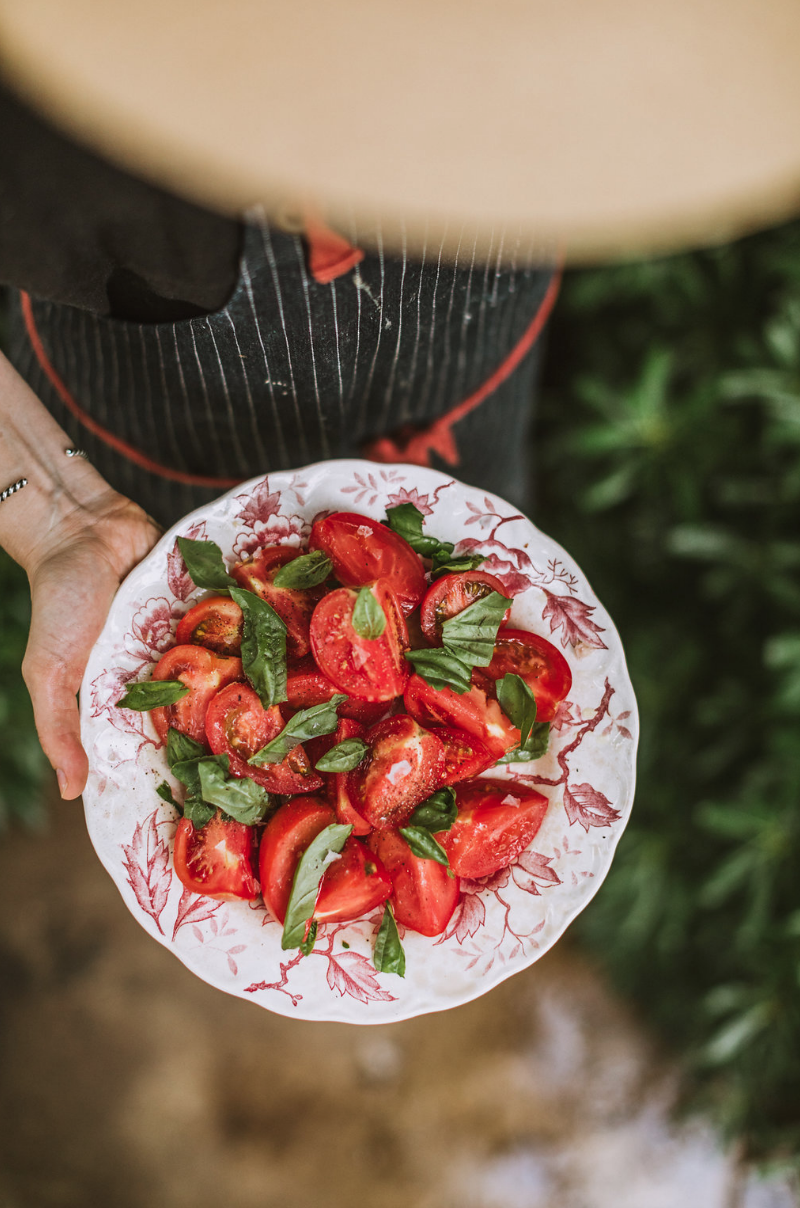 Photo by Rick Cortez.
Photo by Rick Cortez.
Don’t miss out on the opportunity to bulk-purchase our locally grown, certified organic tomatoes for a great deal, straight from our Garfield farm. Tomato season in Texas is short and sweet, and believe it or not, soon enough the heat is going to really kick in and it will be too hot for our Texas tomatoes to set fruit. Get your pre-orders in for these mouth-watering beauties and get to canning, salsa-making, pasta-saucing and more here! Please note: CSA members, log-in to your account prior to ordering bulk tomatoes so that your pick up location/home delivery specifications will show up on the order page.
Next up, our annual Tomato U-Pick! This event is a summer favorite, and we're so excited to host this one-of-a-kind event again. You and your family are invited to our Garfield, Texas tomato fields on Saturday, June 16th to harvest your share of our tomato crop. Rows and rows of juicy red fruit, ripe for the picking. Think large, firm slicers and snackable, sweet cherries... Plum tomatoes and San Marzanos, perfect for preserving.
A note on the kiddos: We might be biased, but we really think this is one of the best events out there for your kids, and we really hope you consider bringing the whole family. The joy that comes from harvesting your own food, especially something as fun as picking a tomato, is hard to quantify. There's nothing quite like running down a row, choosing the perfect tomato, getting your hands a little dirty, and then heading home with the fruits of your labor. It's a memory and a snack, all in one. Check out more info here!
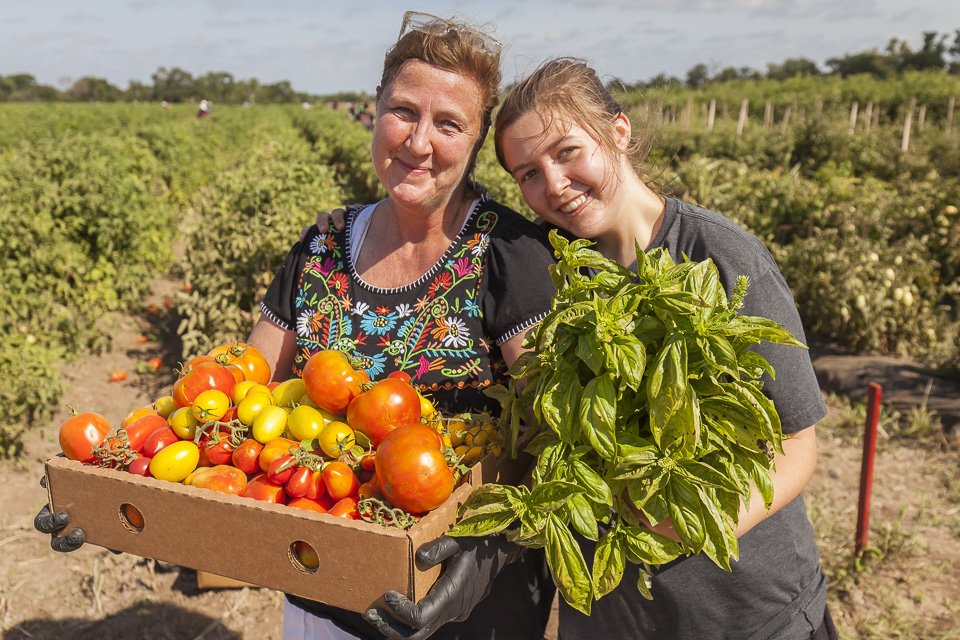 Last year's U-Pick. Photo by Scott David Gordon.
Last year's U-Pick. Photo by Scott David Gordon.
Alright, back to this week’s post!
History of the Tomato
Wild cultivars of the tomato originated in South America - what is today Peru, Bolivia, Chile and the other Andean nations. Native tomato plants produced small, cherry-sized fruit that likely ripened to yellow (not red!). Though it was used as a food product, the tomato was not an important crop and was one of the last Solanum family plants (other include chili peppers, potatoes, and tobacco) to be brought north to Central America during cultural migrations. To this day, a number of wild tomato cultivars can still be found growing across South America!
The Aztec culture is credited with domesticating the tomato and incorporating it into their cuisine - way back in 500 BC. The tomato lived a fruitful, but quiet life until the sack of the Aztec capital Tenochtitlan by Hernan Cortez in 1521. Tomato seeds, among many other treasures, made it back to Europe following the seizing of the city. This jet-set really opened the doors for the future of tomatoes as a global food crop.
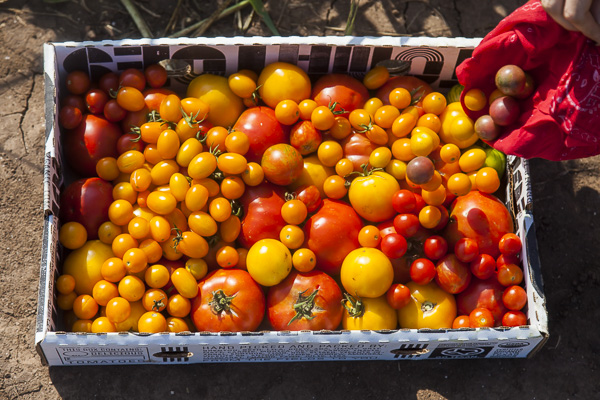 Tomatoes freshly picked. Photo by Scott David Gordon.
Tomatoes freshly picked. Photo by Scott David Gordon.
Across the Atlantic, the tomato underwent extensive breeding, most notably by the Italians, who created new varieties with all kinds of wonderful colors, shapes, and sizes - these fruits probably looked like what we call "heirlooms" today. Interestingly enough, these fruits were first bred as ornamentals, not as a food source! The first appearance of tomatoes in a European cookbook was published in Naples, Italy in 1692.
And who better to bring the glorious tomato back to America than Thomas Jefferson? The Jeffersons grew and bred tomatoes at Monticello, and along with a few other American botanists - most notably a man named Alexander Livingston. The number of tomatoes varieties around the world grew into the thousands! Jeffrey Campbell is another big player in the tomato game, making it a staple in the American household with his condensed tomato soup idea. He wanted to save money on shipping by removing some of the water weight, resulting in the iconic Campbell's Tomato Soup can.
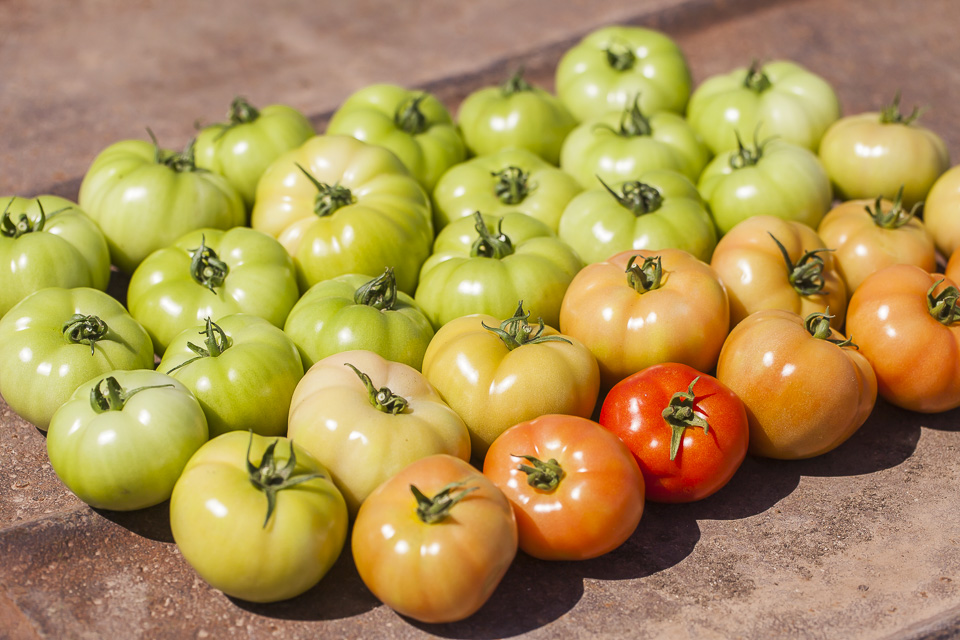 Photo by Scott David Gordon.
Photo by Scott David Gordon.
Tomato Folklore
There are loads of myths, legends, and stories centered around the tomato. The Pueblo nation believed that those who ingested the seeds of a tomato would be given powers of divination, while many people in colonial times believed tomatoes to be poisonous fruits. It was said that eating the fruit of a tomato plant would turn one's blood to acid. Sounds nasty! This misconception may have come from the fact that many toxic members of the nightshade family - mandrake, belladona, and poison nightshade - all look like their cousin, the tomato.
You can't keep a good veggie down though, and by the late 16th century, tomatoes were recognized as not just nonpoisonous, but delicious! The tomato earned a reputation as an aphrodisiac, with nicknames such as pomme d'amour - French for "love apple." In the 1920s, beautiful women were sometimes referred to by the slang phrase "hot tomato."
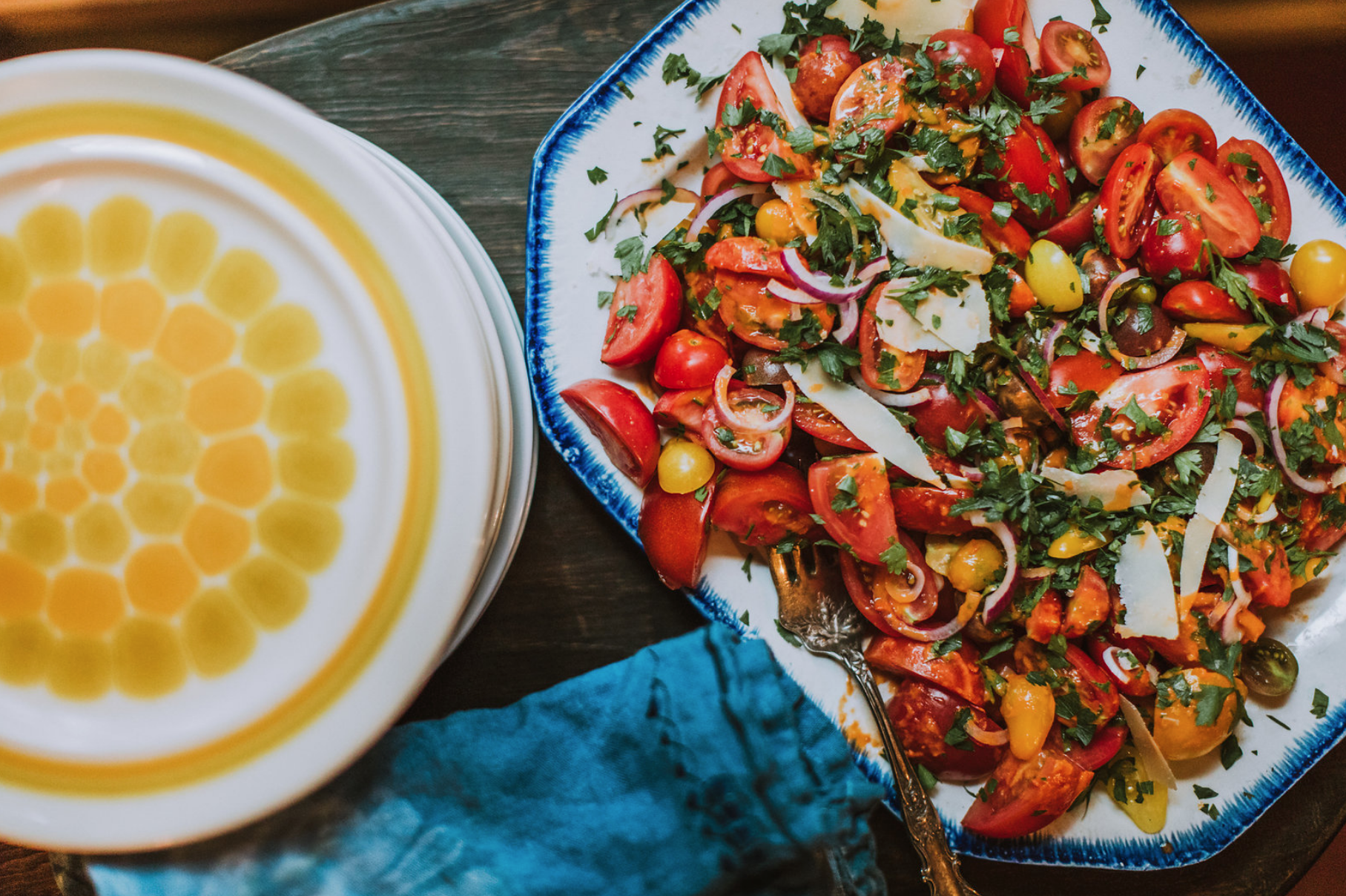 A tomato salad by Mackenzie Smith, begging to be eaten. Photo by Rick Cortez.
A tomato salad by Mackenzie Smith, begging to be eaten. Photo by Rick Cortez.
Fun Facts
Why do we call tomatoes a vegetable, when they are really a fruit? You might blame the Supreme Court - in 1887, Nix v. Hedden determined that tomatoes should be subject to the 10% vegetable tariff that importer John Nix was protesting by importing this exotic "fruit".
In Arkansas, the tomato is both the state fruit AND the state vegetable!
Those hairs on the stems of your tomatoes? Each one has the potential to turn into a root if the stem is placed on the ground. This is why gardeners are encouraged to plant their tomatoes deep.
The town of Buñol, Spain, hosts an annual festival culminating in a giant tomato fight, called La Tomatina.
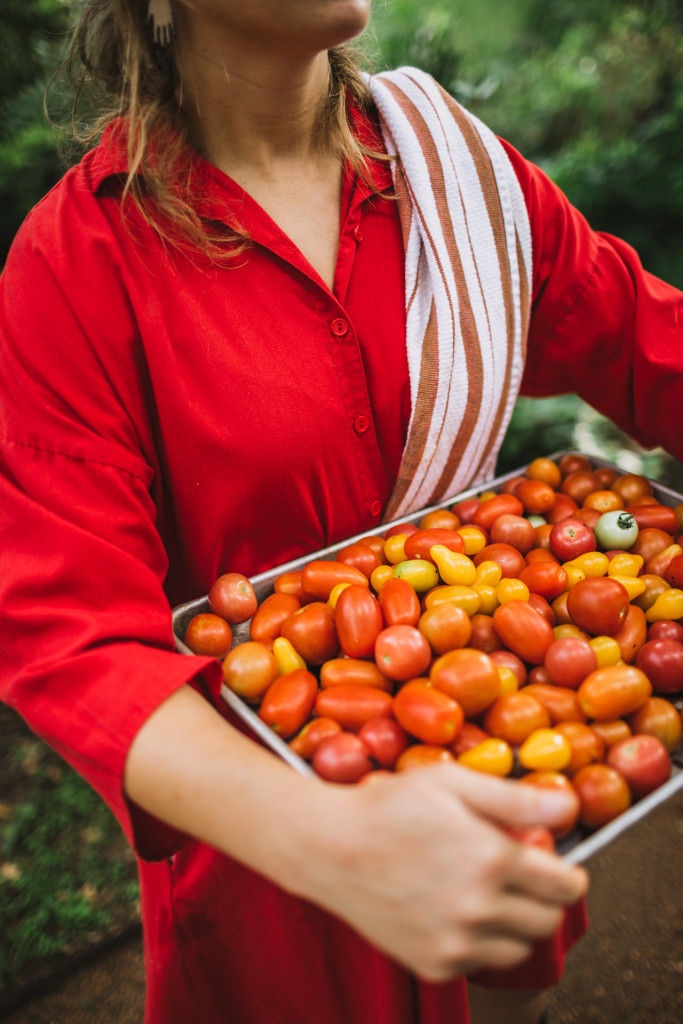 Tray o' tomatoes. Photo by Rick Cortez.
Tray o' tomatoes. Photo by Rick Cortez.
Enjoy those tomatoes! 'Til next time.






 0 ITEMS IN CART
0 ITEMS IN CART 

